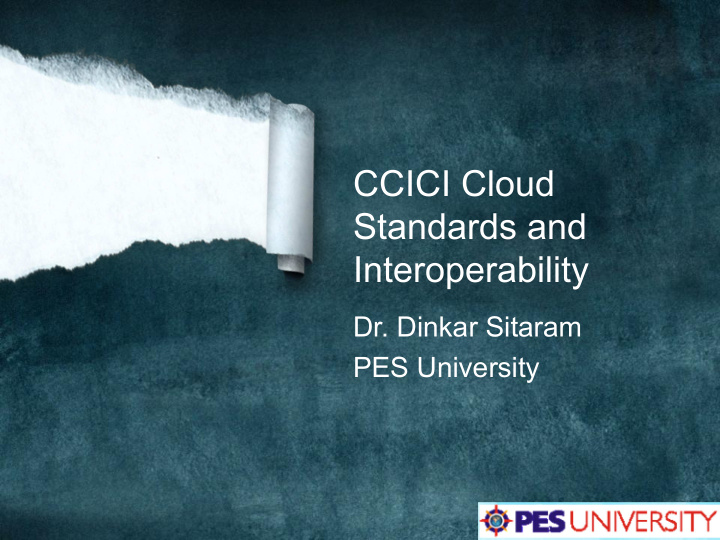



CCICI Cloud Standards and Interoperability Dr. Dinkar Sitaram PES University
Agenda • Why Interoperability – Especially in India • Current Interoperability efforts – ISO – IEEE P2302 • Our efforts
WHY INTEROPERABILITY
Current State of Interoperability Fred was rapidly getting the message that his cloud solution may need more thought
Current State of Interoperability It had been a great party but it was really starting to catch up with Fred and his team
Government is fuelling the adoption of CLOUD 7
Why India? An opportunity to leapfrog in technology Our scale requires us to use cloud
Joint Task Force to Develop Cloud Interoperability and Cloud Standards has been set up Non-profit society • Collaborative platform • Under DoT • Academia • Developing and • Government • promoting Industry • India-specific Mission: Foster growth of • requirements cloud computing Standardizing • Important initiatives • solutions for White paper • meeting these Advisory role to govt • requirements Meity-CCICI Cloud • • Contributing Study these to Interoperability task • international force standards
CURRENT INTEROPERABILITY EFFORTS: ISO AND IEEE-NIST
Highlights of ISO IEC 19941 • Goals – Establish common understanding – Establish common vocabulary • Approach: Define facet model – Cloud Interoperability – Cloud Application portability – Cloud Data portability
Highlights of ISO IEC 19941 • Cloud Interoperability facets
Highlights of ISO IEC 19941 • Cloud Interoperability facets
Highlights of ISO IEC 19941 • Cloud Data Portability Facets
IEEE-NIST P2302 Objectives • Create cloud provider ecosystem – Transparent to users and applications • Dynamic infrastructure to support evolving business models • Infrastructure for economic audit and settlement – In addition to the technical issues
Federation in a Nutshell • User (Org. A) discovers and invokes services in Org. B • Org. B Service Providers – Validate Org. A credentials – Make correct access decisions
§ User in one Regulatory Environment discover federated resources from resource catalog of Federation Broker using its Identity § User invokes required services that belongs to other Regulatory Environment which is part of Federation. § Other Regulatory Environment validates this user credentials and decides on grant/denial of resources based on role and access policies. Similar to having SIMs for different countries say India and US Architecture : User-to-Cloud Federation
§ User in one Regulatory Environment requests for resources from the cloud of which he is a part of. § CSP can serve the request from its resources or from CSP of other Regulatory Environment by connecting via Cloud Broker. § Other Regulatory Environment validates the resource requesting CSP and decides on grant/denial of Similar to calling local network operator resources based on role and access policies. who forwards call to other operator Architecture : Cloud-to-Cloud Federation
Deployment Models
Our Approach • Look at global efforts – ISO – IEEE-NIST Intercloud • Identify value proposition of standards – For customers – For vendors – For Government • Identify gaps
Our Approach • Identify important India- specific use cases – IaaS, PaaS, SaaS use cases • Current use cases – IaaS: eGovernance – SaaS: Smart Cities • Define standards • Setup Interoperability Test Bed
DEMO
CONCLUSIONS & Next Steps S.T.O.R.A.G.E. 2010-11 GOALS C ollaborative Innovation L eadership Industry, Academia, Government, Professional bodies In Global Forums & Accelarating deployment & adoption O penForum>>Outcomes U SMART, Measures of success, Evaluation Framework SAGE SCENARIOS, PLATFORMS & INFRASTRUCTURE, ENABLEMENT FRAMEWORK Working Groups, Discussion Forums, Fortnightly updates D riven by volunteers Passion for technology, spirit of “GIVE BACK” DOES THIS INTEREST YOU ? HERE IS HOW YOU CAN PARTICIPATE AS A COLLABORATOR – Join a WG, Innovation Task Force
CLOUD COMPUTING
Recommend
More recommend